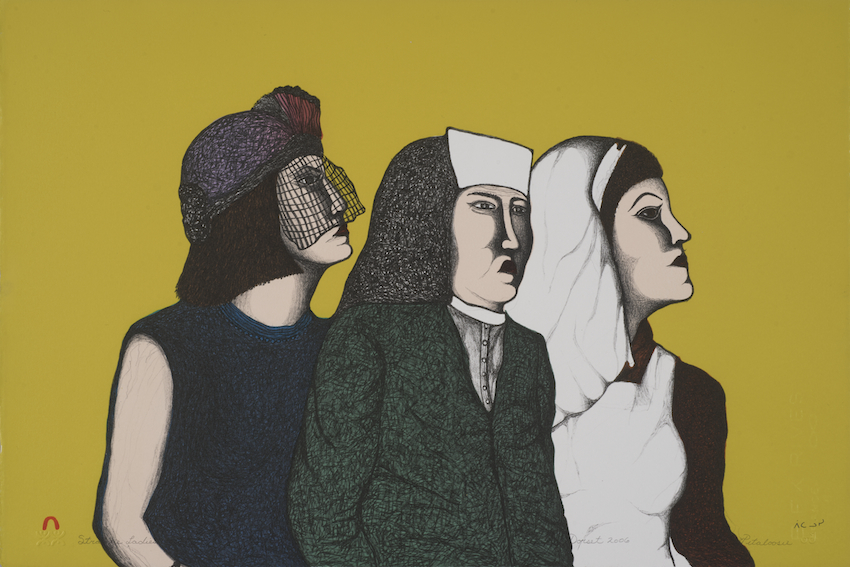
Pitaloosie Saila, (Inuit, Cape Dorset, Canada, b. 1942)
Strange Ladies, 2006 (front cover)
Lithograph, 36/50
22.5 x 15 inches
Reproduced with the permissions of Dorset Fine Arts
“I remember while I was there, the nuns wore black with white hats to go with the uniforms. I don’t know if the patients are still there. I did not enjoy my stay at the hospital at all because I remember being afraid of those nurses.”
— Pitaloosie Saila
Upon suffering a traumatic accident during which she broke her upper back, Saila was evacuated from her Inuit community by a visiting Canadian official and his wife, a nurse, to Southern Canada. She became part of a larger, forcible displacement of Inuit peoples moved to southern hospitals as a result of the Canadian government’s quarantine of Inuit during a tuberculosis outbreak between 1950 and1957. Having spent much of her young life separated from her homelands, Saila drew on her memories from her time away from her community to create an eerie triad of some of the “types” of non-Indigenous peoples the artist encountered (in this case, a nun, a nurse, and a fancy lady). The pallid yellow background around the figure reflects both the unpleasant nature of displacement and also emphasizes the malaise of the experience. With this work, Saila unsettles dominant narratives of Western philanthropy and colonial paternalism as “natural” and “benevolent.” The representation of these three iconic figures against a violent backdrop suggests how notions of welfare and aid color colonial and Inuit interaction since the mid-20th century.
The women in Saila’s print feel all the more “strange” with their foreign vocabulary of dress and meaning, imparting the isolation, fear, and loss Saila may have experienced in her childhood, far south of her Inuit community, surrounded by unfamiliarity and yearning for beadwork and calico patterns. Often, Inuit women separated from their relatives mentally suffered when physically isolated from Inuit fashions and materials. There is a descriptive function of Inuit clothing: it declares one’s role in their specific community. The sparseness of the composition, focused on the Western styles of the three women, makes clear this cultural significance by heightening the juxtaposition between absent Inuit clothing and the depicted Western dress.
The perception of white visitors was one of suspicion, with the preservation of community safety and culture as Inuit’s paramount interests. In Strange Ladies, the women’s disconnected countenances recall a painful part of the artist’s and Inuit cultural memory and echoes a history of oppression. Memory is important in Inuit epistemology, recalling injustices that must continue to be remembered. The body of art produced and sold by the Cape Dorset community provides an example of art that works towards this goal. Saila empowers herself, Cape Dorset, and the collective Inuit memory through her prints.
The Canadian government’s incursion on the Inuit way of life is evident in the infection of tuberculosis as well as the subsequent displacement of the Inuit people. The artist’s choice to depict the colonizers as female types rather than their male counterparts represents a subversion of Western concepts of universal feminism and sisterhood. Saila makes clear that these women are complicit in colonial acts, often justified by “humanitarianism” – Strange Ladies subverts this dominant Western narrative and refocuses our gaze on understanding the Inuit point of view and Inuit peoples’ continuance.
Kristina Arike ’14, Claire Fey ’15, Isaac Lindy ’14
